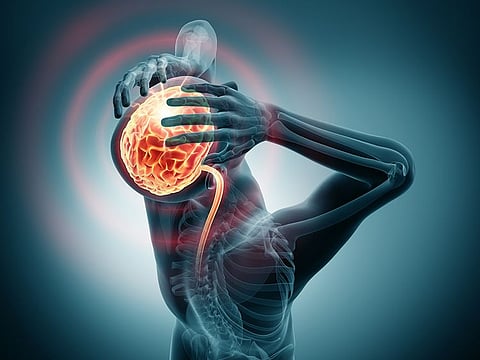F.A.S.T response to stroke
Why it is vital to react quickly to the life-threatening signs and symptoms

A stroke is when part of the blood supply is cut off to the brain. It can be life-threatening and with each minute that passes following a stroke, an individual is at greater risk of permanent brain damage and disability.
Dr Suhail Abdulla Alrukn, Consultant Neurology, DHA, and President of Emirates Neurology Society, says that one of the techniques for raising awareness of stroke and its early symptoms is the acronym F.A.S.T., which is used throughout the world including in the UAE.
“F.A.S.T. is one of the well-known ways of remembering how to recognise the symptoms of stroke. It has been well documented through research that two million brain cells die every minute following a stroke. If a person is showing symptoms of stroke, within one hour they can lose around 120 million brain cells, which will lead to brain damage. This provides clear evidence that early intervention for stroke can save lives and also save people’s quality of life.”
The first letter of F.A.S.T stands for face. If someone’s face has dropped on one side or they are unable to smile, this could be a sign of a stroke. The ‘A’ stands for arms as if a person suffers a stroke, they may be unable to raise and hold both arms up as one may drop. The ‘S’ represents speech. Stroke victims can slur their speech or suffer from difficulties comprehending conversations. The final ‘T’ stands for time, reinforcing the importance of responding quickly and calling 988 immediately for an ambulance.
Dr Alrukn says that due to the high prevalence of stroke, including in the UAE, it is important to raise awareness of both the symptoms and risk factors. “Stroke is the number two cause of mortality worldwide after cardiovascular disease and it is the number one cause of disability,” he says.
“The occurrence of stroke in the Arab World, the Middle East and the GCC affects people at an average of ten years earlier in comparison to Western countries and that’s due to one of the main risk factors being high blood pressure.
“The UAE Minister of Health & Prevention said that in adulthood, around 20 to 25 per cent of the population in the UAE has high blood pressure and 20 to 25 per cent of these people are undiagnosed. Not being treated means these people are at greater risk of stroke.”
He refers to sedentary lifestyles, smoking, a lack of exercise as well as salt consumption as key causes of stroke both globally and regionally. “The international guidelines from the WHO and other organisations show that the daily consumption of salt should be less than 1.2 grams, which is the equivalent to half a teaspoon. Currently, in the GCC, average consumption of salt exceeds 3.5 grams per day. Salt intake increases water retention in the body and causes artery stiffening, which can lead to hypertension.”
Stroke is the number two cause of mortality worldwide after cardiovascular disease and it is the number one cause of disability.

Another significant risk factor for stroke is obesity and diabetes. “Obesity is another big risk factor in the UAE and any resident with a body mass index (BMI) above 28 has a significantly greater risk of stroke due to an increased risk of diabetes and hyperlipidemia. A large part of the young population in the UAE are overweight,” says Dr Alrukn.
“Diabetes and poor blood sugar management increases the risk of stroke by between two and four times.”
Although stroke affects younger than average members of the population in the UAE, Dr Alrukn says the government continues to improve patient care for stroke.
“In 2013, the UAE only had three stroke units and currently we have more than eight units and there are plans to have a total of between 15 to 16 units to cover the whole country. The health authorities in the UAE are making huge investments in improving stroke care and we believe that increases awareness of acute stroke care and treatment will save the quality of patients’ lives, reduce their disability and allow them to return to work following a stroke.”
Sign up for the Daily Briefing
Get the latest news and updates straight to your inbox



